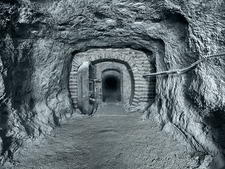1897 – 1937: Potash and rock salt mining in Beendorf and Morsleben
- In 1897 construction of Marie mine started in Beendorf. Later on, the Bartensleben mine was constructed in Morsleben and connected underground to the Marie mine. The mine was created.
- Today, historic devices from the time mining activities took place can be found at several places in the mine. They are witnesses of the repository’s past as potash and rock salt mine.
- As a result of the former mining operation, the mine's cavity volume is today 8 – 9 million cubic metres. Such a large number of cavities presents a challenge for the safe decommissioning of the repository. Part of the cavities has already been backfilled to stabilise the mine.
Marie mine

![]() Shaft sinking crew of Marie mine, 1898
Shaft sinking crew of Marie mine, 1898
Sinking operation of shaft Marie started in May 1897 and was completed in August 1898 at a depth of 370 m. The shaft was constructed with the means available at that time. A wooden cage, shovels, pick axes, explosives and tubs were available to carry out the hard work. A steam engine hoisted the debris to the surface.

![]() Marie mine - historical view 1922
Marie mine - historical view 1922
A potash chloride plant was built in Beendorf in 1903. Using the hot dissolution procedure, it produced fertilizers from crude potash salts mined in the mine. Saline waste water was discharged into the river Elbe from 1913. Mining activities in the Marie mine stopped in 1923. The chemical plant processed crude potash salts from other plants until 1927. Then the processing finally stopped, too. Potash mining in the Upper Aller Valley had stopped for good.
Bartensleben mine

![]() Sealing structure between Bartensleben and Marie mine
Sealing structure between Bartensleben and Marie mine
An ordinance under mining law provided for a second shaft as escape route for mining. After that, the Bartensleben mine was constructed in Morsleben in 1910 and connected to the Marie mine.
With interruptions, rock salt was mined here until 1969. The history of the Morsleben repository for radioactive waste started in 1971.
Significance of mining for the operation and decommissioning of the repository
In the past, single large pieces of rock fell from the ceiling in the central part of the Bartensleben mine. This was caused by the high excavation ratio and was thus a direct consequence of mining. The Federal Office for Radiation Protection (BfS) has meanwhile carried out extensive stabilisation measures in the central part.
Another result of mining are places where water from the overburden or originating from the time where the salt structure formed is collected. These places are observed and monitored on a regular basis.
As a result of the former mining operation, the mine has now a cavity volume of 8 – 9 million cubic metres. Such a large number of cavities presents a challenge for the safe decommissioning of the repository. The concept for the decommissioning of the repository provides for backfilling of the major portion of the cavities with salt concrete.
| Year | Event |
|---|---|
| 250 million years ago | Salt forming and subsequent generation of the salt structure |
| 1861 | World-wide, first mining of potash in Staßfurt, Saxony-Anhalt |
| 1897 - 1898 | The businessman Gerhard Korte commissioned the construction of a mine in Beendorf and named it after his wife Marie |
| 1898 - 1923 | Mining of potash salts in Marie mine |
| 1910 - 1912 | Construction of Bartensleben mine in Morsleben: The mine was connected underground to the Marie mine |
| 1912 - 1918 | Mining of potash salt in the Bartensleben mine. The salt was processed on the premises of the Marie mine |
| 1918 - 1969 | Production of rock salt in the Bartensleben mine. The table salt was sold as "Sun salt from Bartensleben" |
State of 2017.01.03

